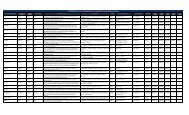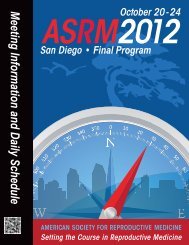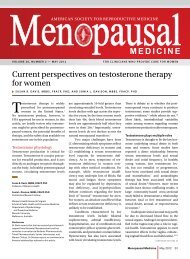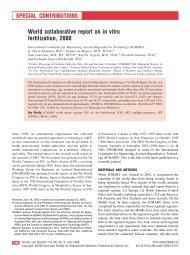scientific program • symposia - American Society for Reproductive ...
scientific program • symposia - American Society for Reproductive ...
scientific program • symposia - American Society for Reproductive ...
You also want an ePaper? Increase the reach of your titles
YUMPU automatically turns print PDFs into web optimized ePapers that Google loves.
44 TH ANNUAL POSTGRADUATE PROGRAM<br />
NEEDS ASSESSMENT AND COURSE DESCRIPTION<br />
Endometriosis is a highly prevalent disease. However there are many knowledge gaps in the pathophysiology and<br />
treatment resulting in delivery of poor care to patients. This disease places a tremendous burden on society both<br />
economically and related to quality of life. The principal manifestations of the disease of infertility and chronic pain<br />
mandates that all subspecialists and general gynecologists are ultimately involved in the care of these patients.<br />
This one-day course, aimed at physicians, nurses, laboratory scientists and social workers who work with endometriosis<br />
patients, is designed to critically address the current knowledge of mechanisms of pain and infertility, as well as current<br />
recommendations of medical and surgical management in these patients. Topics to be discussed include: pathophysiology<br />
of endometriosis-associated pain syndromes, including the relationship with nerve fibers; pathophysiology of endometriosisassociated<br />
infertility; choosing an appropriate medical therapy <strong>for</strong> managing chronic pain and its recurrence; technical<br />
aspects of surgical approaches; and IVF approaches, including pre-IVF optimization. Coherent summaries with key learning<br />
points will be provided and rein<strong>for</strong>ced during the session of case reports.<br />
LEARNING OBJECTIVES<br />
After participating in this course, participants should be able to:<br />
1. Discuss clinical implications of the pathophysiology of endometriosis in patients with chronic pain and infertility.<br />
2. Compare and contrast feasible medical therapy <strong>for</strong> endometriosis and the role of surgery <strong>for</strong> managing chronic pain.<br />
3. Describe the options <strong>for</strong> managing endometriomas be<strong>for</strong>e an IVF cycle.<br />
4. Discuss the optimal approach <strong>for</strong> an IVF cycle in a woman with endometriosis.<br />
________________________________________________________________________________________________________________________<br />
Developed in Cooperation with the Fibroid Special Interest Group<br />
FACULTY<br />
Serdar E. Bulun, M.D., Chair<br />
Ayman Al-Hendy, M.D., Ph.D.<br />
Elizabeth A. Stewart, M.D.<br />
ACGME COMPETENCY<br />
Patient Care<br />
UTERINE FIBROIDS AND REPRODUCTIVE FUNCTION<br />
Course PG18 (Sunday) <strong>•</strong> ROOM 232 A/C CME<br />
NEEDS ASSESSMENT AND COURSE DESCRIPTION<br />
Uterine fibroids are the most common tumors of women and are associated with excessive uterine bleeding, anemia,<br />
recurrent pregnancy loss and infertility in up to 25% of reproductive-age women. Although it can be argued that<br />
uterine fibroids are the most common gynecologic pathology associated with significant morbidity, many pathologic or<br />
therapeutic aspects of these tumors remain debatable or unknown. Over the past few years, there has been substantial<br />
progress regarding our knowledge of pathology and treatment of uterine fibroids. However, there remains a gap between<br />
the classical textbook knowledge and these recent improvements.<br />
This course, designed to update clinicians and researchers, will summarize the scope of the problem, provide cuttingedge,<br />
clinically relevant data <strong>for</strong> practitioners and patients, and describe a framework <strong>for</strong> future advances that may<br />
reshape the standard of care and optimize the therapeutic outcomes in patients affected by symptomatic uterine fibroids.<br />
Cost analysis of treatment choices will also be addressed.<br />
LEARNING OBJECTIVES<br />
After participating in this course, participants should be able to:<br />
1. List the currently available treatments <strong>for</strong> symptomatic fibroids, as well as their indications, limitations, efficacy and side<br />
effects.<br />
2. Explain the use of ART and treatments directly related to fibroids in the management of pregnancy loss or infertility<br />
associated with fibroids.<br />
3. Describe the mechanism of disease associated with uterine fibroids.<br />
________________________________________________________________________________________________________________________<br />
52








